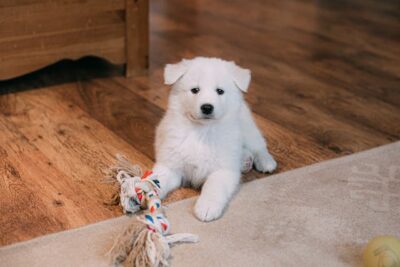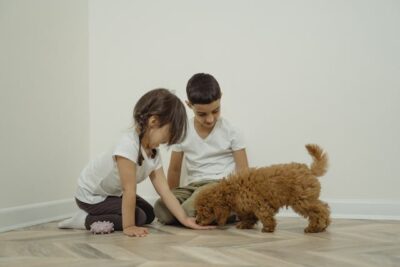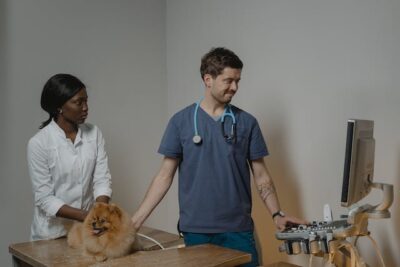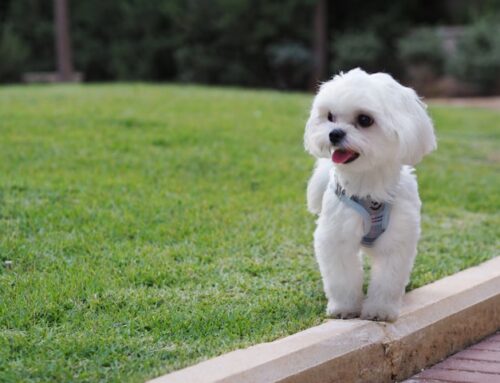Overview
Introduction: When Can Puppies Leave Their Mom

Welcoming a new puppy into your life is a delightful and heartwarming experience. However, understanding when the right time is for puppies to leave their mom is not just important; it's crucial for their overall well-being and proper development. In this comprehensive guide, we will explore the multifaceted journey of puppy separation, including when can puppies leave their mom.
We'll cover everything from comprehending the various stages of puppy development to recognizing the signs that indicate they are ready to leave their mother. Additionally, we will shed light on the pivotal roles of responsible breeders and considerations for those looking to adopt a furry companion.
Puppy Development Stages: A Journey of Growth and Discovery
Understanding the stages of a puppy's development is essential when considering when they can leave their mother and transition to their new home. Let's take an in-depth look at each stage that will guide us through this exciting journey of "when can puppies leave their mom."

Neonatal Stage (zero – two weeks)
During the first few weeks, puppies are entirely dependent on their mother. They rely on her for nourishment, warmth, and protection. Mother's milk provides essential nutrients, and her presence ensures their safety.
Puppies are born blind and deaf, and their senses slowly awaken during this stage. While they may not leave their mother's side, they are beginning their journey toward independence.
Transitional Stage (2-4 weeks)
As puppies enter the transitional stage, their world starts to expand beyond the mother's presence. They begin to explore their surroundings and interact with their littermates. This is a critical period for early socialization, as they learn vital skills like bite inhibition through play.
The introduction of solid food marks another milestone in their development, as they take their first steps towards being fully weaned. This stage typically occurs around the time when puppies open their eyes, which is usually between 10 to 14 days after birth.
Socialization Stage (3-12 weeks)
The socialization stage is a crucial phase in a puppy's development, spanning from 3 to 12 weeks of age. During this time, they form bonds with their littermates and engage in playful interactions. Interacting with other dogs, both within and outside the litter, teaches them important lessons about canine communication.
As they approach seven weeks, many puppies are ready to leave their mother and join their new families, equipped with basic social skills.

Juvenile Stage (3-6 months)
The juvenile stage marks a period of significant growth and learning. Puppies begin to explore the world with curiosity and enthusiasm. Teething, which typically starts around 3 to 4 months of age, is a common aspect of this stage. During teething, puppies may experience discomfort and chew more to relieve it.
House training and basic commands also become part of their daily routine. This stage is crucial for preparing them for life as independent dogs. Responsible dog owners ensure their puppies are crate-trained and introduced to house training during this time.
Adolescent Stage (6-18 months)
As puppies enter adolescence, their journey toward adulthood continues. They build on the lessons learned in earlier stages, refining their behavior and social skills. This phase may present challenges, but with proper guidance from dog owners, most dogs successfully navigate this period. It's a time when they establish a strong bond with their new families, setting the foundation for lifelong companionship.

Natural Weaning Process: Nurturing Independence
Understanding the natural weaning process is essential when considering the question, "When can puppies leave their mom?" Let's delve into the role of the mother dog and the signs that indicate a puppy's readiness for this significant transition.
Mother's Role in Weaning
The mother dog plays a pivotal role in the weaning process, which typically begins around three to four weeks of age. At this stage, puppies start to show interest in solid food. Mother's milk remains vital, but her role gradually shifts from exclusive nourishment to guidance and socialization. She introduces her offspring to solid food by regurgitating partially digested meals. This interaction encourages the puppies to explore new tastes and textures.
As the weeks progress, the mother's milk production decreases, signaling the puppies to rely more on solid food for sustenance. While still providing comfort and security, the mother begins to gently discourage nursing. This shift initiates the weaning process, a crucial step in a puppy's journey toward independence.

Minimum Age for Separation: Factors to Consider
When can puppies leave their mom? Determining the minimum age for puppies to leave their mother is a critical decision that involves considering various factors, including common misconceptions, legal requirements, and breed-specific variations. Let's explore these aspects to ensure the well-being of both puppies and their new owners.
Common Misconceptions
One common misconception is that puppies can safely leave their mother at a fixed age, such as eight weeks. While this age is a general guideline, it's essential to remember that each puppy develops at its own pace. Some may be ready for separation a bit earlier, while others may benefit from staying longer with their mother and litter.
Another misconception is that separating puppies too early will result in more manageable behavior. In reality, the opposite is often true. Puppies learn valuable social and behavioral lessons from their mother and siblings during their early weeks. Separating them prematurely can lead to behavioral issues later in life.
Legal Requirements
Legal requirements regarding the minimum age for puppy separation can vary by location. Some regions have specific regulations that dictate when puppies can be legally adopted or sold. It's crucial for breeders and new owners to be aware of these local laws and adhere to them.
However, it's essential to note that legal requirements are typically established as a minimum standard. They may not necessarily align with what is best for the puppies' physical and behavioral development. Responsible breeders often consider these legal requirements but prioritize the well-being of the puppies above all else.
Breed Variations
Different dog breeds may have varying timelines for puppy separation. Smaller breeds may mature more quickly than larger ones, affecting when they are ready to leave their mother. Additionally, breed-specific characteristics, such as temperament and energy levels, can influence the ideal separation age.
Breeders who specialize in specific breeds often have a deep understanding of these variations and can provide valuable guidance to new owners. They can assess each puppy individually and recommend an appropriate separation age based on the breed's unique characteristics.

Factors Influencing the Timing of Puppy Separation
Determining the right time for puppies to leave their mother involves considering various factors that impact their physical and behavioral development. Here, we'll delve into these factors, including health considerations, vaccinations, weaning progress, socialization needs, and behavioral development.
Health Considerations
One crucial factor in deciding when puppies can safely leave their mother is their overall health. Puppies should be examined by a veterinarian to ensure they are free from diseases or health issues that could pose a risk when transitioning to a new home. Vaccinations play a significant role in this aspect, as they protect puppies from common illnesses.
Vaccinations
Puppies typically receive a series of vaccinations in their early weeks to build immunity. It's essential to complete this vaccination schedule before considering separation. Adequate vaccination helps protect puppies from contagious diseases they might encounter in their new environment.
Weaning Progress
The weaning process is another vital factor. Puppies start transitioning from mother's milk to solid food at around three to four weeks of age. Weaning should be gradual to ensure puppies are fully accustomed to solid food before separation. A breeder or mother dog often guides this process.
Socialization Needs
Puppies have a critical socialization period between three and twelve weeks of age. During this time, they learn essential social skills, bite inhibition, and how to interact with other dogs and people. Staying with their mother and litter during this phase is crucial for proper socialization.
Behavioral Development
Behavioral development continues as puppies grow. They learn important lessons from their mother, such as discipline and proper play behaviors. Separating them too early can disrupt this learning process and lead to behavioral issues in the future.

Signs of Puppy Readiness
Determining when puppies can leave their mother also involves recognizing signs of readiness. Puppies need to be emotionally and behaviorally prepared for the transition to their new homes. Here are the key signs to look for:
Independence
One of the signs that a puppy is ready to leave its mother is developing a sense of independence. As puppies grow, they naturally start exploring their surroundings and become less reliant on their mother. They may begin to eat solid food and rely less on mother's milk. While still benefiting from their mother's presence, they show an increased desire for autonomy.
Social Skills
Proper socialization is essential for puppies. By spending time with their mother and littermates, puppies develop crucial social skills. They learn how to interact with other dogs, understand social hierarchies, and develop bite inhibition. Puppies that have learned these social skills are better equipped to adapt to new environments and bond with their future families.
Basic Training
Puppies exhibit a readiness for basic training when they can grasp simple commands and instructions. While still with their mother and littermates, they often learn fundamental behaviors, such as responding to their names or basic commands like "sit" or "stay." This readiness for basic training signifies that they are mentally prepared to learn and adapt to their new homes.
Recognizing these signs of independence, social skills, and basic training readiness is crucial for determining when puppies can safely leave their mother. It ensures that they can transition smoothly into their new homes, where further training, including potty training, and bonding with their new families will take place.

Preparing for Separation
The moment when puppies leave their mother and transition to their new homes is a significant one. To ensure a smooth and comfortable transition, certain preparations are essential:
Safe Living Space
Before bringing your new puppy home, it's crucial to create a safe and secure living space. Puppies are naturally curious and may get into mischief if their environment isn't puppy-proofed. Remove any hazards, such as toxic plants, small objects, or chemicals, that could harm your furry companion. Use baby gates to block off areas that are off-limits and invest in a comfortable and safe crate where your puppy can rest.
Necessary Supplies
Gather all the necessary supplies to make your puppy's homecoming a success. This includes:
- Food and Water Bowls: Choose sturdy, non-tip bowls that are easy for your puppy to reach.
- Quality Puppy Food: Consult your veterinarian or breeder for recommendations on the best puppy food for your specific breed.
- Collar and Leash: Even young puppies can benefit from getting used to a collar and leash for short walks and outings.
- Bed and Bedding: Provide a soft and comfortable bed for your puppy to sleep on.
- Toys: Puppies love to play, and having a variety of toys can keep them mentally and physically engaged.
- Grooming Supplies: Depending on your puppy's breed, you may need grooming tools like brushes and nail clippers.
- Cleaning Supplies: Be prepared for accidents with pet-friendly cleaning products.
- Identification: Ensure your puppy has proper identification, including a collar with an ID tag and, if possible, a microchip.
Emotional Preparation
Puppies are highly sensitive to their owners' emotions, so it's essential to be emotionally prepared for their arrival. Anticipate the joy and challenges that come with caring for a young pup. Be patient, consistent, and ready to provide love, attention, and positive reinforcement to help your new furry family member adjust to their new home.

The Ideal Age Range
Determining the ideal age for puppies to leave their mother is a critical decision, as it significantly impacts their development and well-being. Let's delve into this age range in more detail:
Sweet Spot for Separation
The sweet spot for separating puppies from their mother typically falls within a specific age range, which is around 7 to 8 weeks old. This age is often considered the best time to transition puppies to their new homes. There are several compelling reasons why this age is regarded as optimal.
At around 7 to 8 weeks, puppies have had the opportunity to benefit fully from their mother's milk. This early nourishment provides essential nutrients and antibodies crucial for their early development. Additionally, their mother has played a vital role in teaching them fundamental lessons about socialization, bite inhibition, and appropriate play behaviors.
Benefits of Waiting
Waiting until seven-week old puppy or eight weeks before separating puppies from their mother offers numerous advantages for both the puppies and their new owners:
- Learning Important Skills: During their time with their mother and littermates, puppies acquire vital social skills and bite inhibition. These skills lay the foundation for becoming well-adjusted adult dogs.
- Building a Strong Bond: Puppies form a strong bond with their mother and littermates during this period. This early bond-building contributes to their ability to establish healthy relationships with humans and other dogs later in life.
- Receiving Critical Lessons: Their mother provides essential lessons in behavior and discipline, teaching them what is acceptable and what is not in doggy social dynamics.
- Developing Proper Play Behaviors: Puppies engage in play with their littermates, learning the boundaries of playfulness and the importance of gentle interactions.
Risks of Delaying
While waiting until the seven weeks to eight weeks is generally beneficial, delaying separation beyond this point can have its drawbacks:
- Dependency: Puppies that stay with their mother and littermates for an extended period might become overly dependent, making the transition to a new home more challenging.
- Missed Socialization Opportunities: Delaying separation may limit early socialization experiences with humans and the outside world, potentially leading to fear or anxiety issues.
- Difficulty in Rehoming: Older puppies may be harder to find homes for, as many prospective owners prefer younger puppies.

The Separation Process: Ensuring a Smooth Transition for Your Puppy
Bringing your new companion home is an exciting moment, but the separation process from their mother and littermates requires careful consideration and planning. Let's explore the steps to ensure a smooth transition for young pups:
Gradual Transition
A gradual transition is key to helping your puppy adjust to their new environment. Here's how to do it:
- Familiarity: In the first few days, create a space for your puppy that resembles their previous living area as closely as possible. This familiarity provides comfort during the initial transition.
- Interaction: Spend time with your puppy in their designated space. Allow them to explore at their own pace and interact with you. Patience is crucial as they adapt to their new surroundings.
- Gradual Separation: Begin by separating your puppy from their mother and littermates for short periods, gradually increasing the duration. This helps them get used to being alone, which is essential for their independence.
First Days at the New Home
The first days at the new home are crucial for your puppy's adjustment:
- Quiet Introduction: Limit the number of people and pets your puppy interacts with during the initial days. This reduces stress and allows them to bond with you at their own pace.
- Routine: Establish a daily routine that includes regular feeding, playtime, and bathroom breaks. Puppies thrive on routine, and it helps them feel secure in their new environment.
- Positive Reinforcement: Use positive reinforcement to reward good behavior. Treats, praise, and gentle petting go a long way in helping your puppy feel loved and secure.
Monitoring Adjustment
Monitoring your puppy's adjustment is an ongoing process:
- Behavioral Observations: Pay close attention to your puppy's behavior. Look for signs of stress, fear, or anxiety, such as excessive whining or hiding. Address these issues with patience and positive reinforcement.
- Socialization: Begin early socialization by introducing your puppy to various people, animals, and environments. Positive experiences during this critical period will help them grow into well-adjusted adult dog.
- Training: Start basic training exercises as early as possible. This not only builds good behavior but also strengthens the bond between you and your puppy.
- Health Check: Schedule a vet visit to ensure your puppy is healthy and up-to-date on vaccinations. Discuss a feeding schedule and any specific dietary needs.

Navigating Separation Challenges with Your Puppy
Bringing your puppy home is a joyful experience, but it can also come with a set of challenges as your furry friend adjusts to their new environment. Let's explore these challenges and how to address them:
Separation Anxiety
- Recognizing Separation Anxiety: Some puppies may develop separation anxiety when left alone. Signs include excessive barking, destructive behavior, and soiling indoors. Recognizing these signs early is crucial.
- Gradual Alone Time: To combat separation anxiety, gradually increase the time your puppy spends alone. Start with short intervals and gradually extend them as your pup becomes more comfortable.
- Crate Training: Crate training can provide your puppy with a safe and secure space. Introduce the crate as a positive place and use it when you're away. Gradually increase crate time to build your puppy's confidence.
- Positive Goodbyes and Hellos: Keep goodbyes and hellos low-key to prevent heightened emotions. Offer a treat or toy as a distraction when leaving.
Littermate Syndrome
- Understanding Littermate Syndrome: If you have adopted two puppies from the same litter, they may develop littermate syndrome. This can lead to over-dependence on each other and difficulties in training.
- Separate Training: To prevent littermate syndrome, provide separate training sessions, playtimes, and feeding times. This encourages independence and strengthens the bond between each puppy and their owner.
- Socialization: Ensure that each puppy has opportunities for individual socialization with other dogs and people to avoid exclusive reliance on their littermate.
Correcting Undesirable Behaviors
- Positive Reinforcement: Use positive reinforcement techniques to correct undesirable behaviors. Reward good behavior with treats, praise, and attention.
- Consistency: Consistency is key when addressing behavioral issues. Establish clear rules and boundaries for your puppy and stick to them.
- Professional Help: If your puppy's behavioral problems persist or worsen, consider seeking the help of a professional dog trainer or behaviorist.

Choosing Responsible Breeders vs. Unscrupulous Breeders
When you decide to bring a new puppy into your home, one of the most critical decisions you'll make is choosing a responsible breeder. Here's how to make an informed choice:
Questions to Ask
- Health Screening: Inquire about health screenings for the puppy's parents. Responsible breeders conduct tests to rule out genetic conditions common to the breed.
- Socialization: Ask about the socialization process. A good breeder exposes puppies to various stimuli and experiences during their early weeks.
- Diet and Care: Discuss the puppy's diet and care routine. Reputable breeders ensure that puppies receive proper nutrition and healthcare.
- Parental Temperament: Learn about the temperament of the puppy's parents. A breeder should be able to provide information about their dogs' behavior and disposition.
- References: Request references from previous puppy buyers. Speaking to others who have purchased from the breeder can provide valuable insights.
- Registration and Documentation: Ensure the breeder provides the necessary registration papers, vaccination records, and a health guarantee.
Breeder's Role in Timing
Responsible breeders play a crucial role in determining the right time for puppies to leave their mother. Here's how they contribute to the timing:
- Observation: Breeders closely observe the puppies from birth, noting their developmental milestones and behaviors.
- Weaning Process: They initiate the weaning process by introducing solid food gradually and monitoring the puppies' ability to eat independently.
- Health Assessments: Breeders ensure that puppies are in good health before they leave for their new homes. This includes vaccinations and deworming.
- Behavioral Evaluations: They assess the puppies' behavior, looking for signs of readiness for independence and socialization.
- Educating New Owners: Responsible breeders educate new owners about the importance of proper care and early training for the puppies.

Professional Guidance
While your journey with your new puppy is filled with joy and excitement, it's essential to seek professional guidance to ensure their well-being and development. Here are ways professionals can assist you:
Veterinarian's Role
- Health Assessment: Your veterinarian plays a crucial role in your puppy's life. Schedule regular check-ups to monitor your puppy's health, vaccinations, and overall well-being. They can identify and address any health concerns.
- Vaccination Schedule: Your vet will provide guidance on your puppy's vaccination schedule to protect them from common diseases. Staying up-to-date with vaccinations is vital.
- Parasite Control: Parasites like fleas, ticks, and worms can harm your puppy. Your vet will recommend appropriate prevention and treatment measures.
- Spaying/Neutering: Discuss the timing of spaying or neutering with your veterinarian. This procedure is often done when the puppy reaches the appropriate age to prevent unwanted litters and address certain health concerns.
- Diet and Nutrition: Get advice on your puppy's diet, portion sizes, and any specific dietary requirements based on their breed and age. A balanced diet is essential for their growth.
- Behavioral Guidance: If your puppy displays any behavioral issues, such as aggression, anxiety, or excessive barking, consult your vet. They can offer guidance or refer you to a qualified trainer or behaviorist.
Seeking a Trainer's Advice
- Professional Training: Enroll your puppy in a reputable puppy training class or hire a certified dog trainer. Professional trainers can help with obedience training, socialization, and addressing behavior problems.
- Socialization Skills: Trainers can assist in properly socializing your puppy, exposing them to various people, dogs, and environments. Early socialization is crucial for their development.
- Bite Inhibition: Trainers can teach your puppy bite inhibition, a vital skill that prevents aggressive biting as they grow older. This is especially important for households with children.
- Crate Training and Housebreaking: If you're struggling with crate training or housebreaking, a trainer can provide effective strategies and guidance.
- Positive Reinforcement: Qualified trainers use positive reinforcement techniques to encourage good behavior and discourage undesirable actions without resorting to punishment.

Summary: When Can Puppies Leave Their Mom
Final Thoughts: When Can Puppies Leave Their Mom
Bringing a new puppy into your life is a joyful experience, but it also comes with responsibilities and challenges. Understanding the process of when puppies can leave their mom is crucial for ensuring the well-being and proper development of your furry companion.
Responsible breeders play a pivotal role in determining the right time for puppies to leave their mother, considering factors such as health, socialization, and behavioral readiness. The ideal age range for separation typically falls around 7 to 8 weeks, allowing puppies to benefit fully from their mother's care and guidance.
Preparing for your puppy's arrival involves creating a safe and comfortable living space, gathering necessary supplies, and being emotionally ready for the new addition to your family. A gradual transition, positive reinforcement, and consistent training are essential for helping your puppy adjust to their new environment.
Seeking guidance from professionals, such as veterinarians and dog trainers, can provide valuable support in ensuring your puppy's health, behavior, and socialization needs are met. By understanding the separation process and providing a loving and structured environment, you can set your puppy up for a happy and fulfilling life as a cherished family member.
Check out our listing for puppies for sale in Georgia and surrounding areas, thoughtfully bred and raised by reputable breeders. Experience the joy of bringing home the perfect puppy for your family with our carefully curated collection of puppies for sale. We are also selling puppies in Florida and surrounding areas.
Frequently Asked Questions (FAQs): When Can Puppies Leave Their Mom
1. When is the ideal age for puppies to leave their mom?
- The ideal age for most puppies to leave their mom is typically around 8 weeks old. This allows them to benefit from crucial mother's milk and early socialization.
2. Why is it important for puppies to stay with their mother and littermates during the first few weeks?
- Puppies staying with their mother and littermates during the first few weeks helps them learn important social and behavioral skills. They develop bite inhibition and learn how to interact with other dogs.
3. Can puppies be safely separated from their mother earlier than 8 weeks?
- While it's possible to separate other puppies from their mother earlier, it's generally not recommended. Puppies depend on their mother for nutrition and essential life lessons during this time.
4. What happens if puppies are taken away from their mother too early?
- Early separation from their mother can lead to behavioral issues and difficulties in learning important skills. It's best to wait until they are at least 8 weeks old.
5. Are there legal requirements for the minimum age at which puppies can be adopted?
- Many places have legal requirements that puppies must be at least 8 weeks old before they can be legally adopted or sold.
6. How can I identify responsible breeders who prioritize the well-being of puppies?
- Responsible breeders prioritize the health and development of puppies. They provide a safe and clean environment, ensure proper socialization, and adhere to legal requirements.
7. What are the risks associated with adopting puppies from unscrupulous breeders?
- Unscrupulous breeders may not provide proper care, leading to health issues and behavioral problems in puppies. It's essential to research and choose breeders carefully.
8. What is the role of dog owners in preparing for a new puppy's arrival?
- Dog owners should prepare a safe living space, gather necessary supplies, and emotionally prepare for the responsibilities of puppy care and training.
9. How can I help my puppy adjust to their new home during the first days?
- Gradual transition, providing comfort, and sticking to routines can help puppies adapt to their new home more smoothly.
10. What should I do if my puppy exhibits separation anxiety after leaving their mother?
- If your puppy shows signs of separation anxiety, consult a professional trainer or behaviorist for guidance on addressing this issue.
11. What are the benefits of waiting until the recommended age to separate a puppy from their mother?
- Waiting until the recommended age allows puppies to develop essential skills, ensuring better physical and behavioral health in the long run.
12. What are the risks associated with delaying a puppy's separation from their mother?
- Delaying separation for too long can lead to overcrowding and increased competition among puppies, potentially causing stress and developmental issues.
13. How can I build a strong bond and trust with my new puppy?
- Building trust and a strong bond with your puppy involves spending quality time together, using positive reinforcement, and providing love and care.
14. When should I seek professional guidance for my puppy's development and behavior?
- It's advisable to seek professional guidance from veterinarians and trainers if you encounter any health concerns or behavioral issues with your puppy.
15. What is the importance of early socialization for puppies?
- Early socialization exposes puppies to various experiences, people, and dogs, helping them develop into well-adjusted and confident adult dogs.
16. Can you explain the weaning process and its significance for puppies?
- Weaning is the gradual transition from mother's milk to solid food. It's a critical stage in a puppy's development as it prepares them for independent eating.
17. What should I know about the fear period in puppies and how to handle it?
- The fear period is a stage where puppies may be more sensitive to new experiences. It's important to expose them to positive, controlled situations to build confidence.
18. What are some important lessons that puppies can learn from their mother and littermates?
- Puppies learn bite inhibition, play behaviors, and social skills from their mother and littermates, which are essential for their future interactions with other dogs and people.
19. How can I ensure my new puppy's safety during the first few weeks at home?
- Puppy-proof your home by removing hazards, providing safe living space, and closely supervising your puppy to prevent accidents.
20. What should I do if my puppy exhibits undesirable behaviors, such as excessive biting or chewing?
- Seek guidance from professional trainers or behaviorists to address undesirable behaviors using positive reinforcement techniques.




